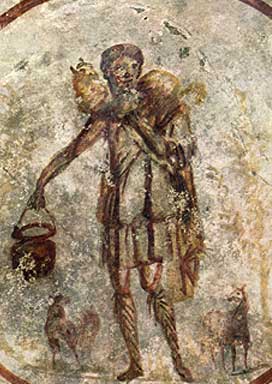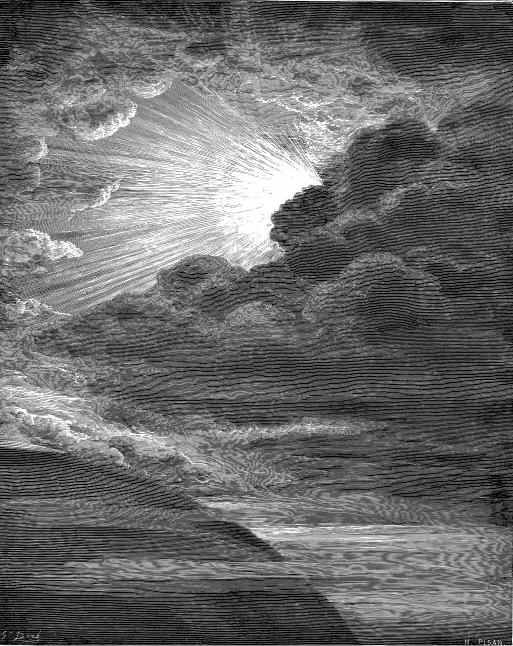|
Statuette Of The Good Shepherd
The Statuette of the Good Shepherd is a marble statuette formerly part of a sarcophagus that dates to the late third or early 4th century A.D. found in the Catacomb of Callixtus. It was reworked in 1764 to become an independent statuette. Above the base, the statue underwent restoration in the 18th century and partial recreation of missing sections. Parts reworked include the upper part of the head, the lamb's legs, the back of the statue, one of the shepherd's legs and both his arms. The statuette illustrates Christ as the Good Shepherd, written of in the Bible's Parable of the Lost Sheep. From Luke 15, verses 3-7: :3 And he (Christ Jesus ( AD 30 or 33), also referred to as Jesus Christ, Jesus of Nazareth, and many other names and titles, was a 1st-century Jewish preacher and religious leader. He is the Jesus in Christianity, central figure of Christianity, the M ...) spake this parable unto them, saying, :4 What man of you, having an hundred sheep, if he lose on ... [...More Info...] [...Related Items...] OR: [Wikipedia] [Google] [Baidu] [Amazon] |
Good Shepherd
The Good Shepherd (, ''poimḗn ho kalós'') is an image used in the pericope of , in which Jesus in Christianity, Jesus Christ is depicted as the Good Shepherd who lays down his life for his sheep. Similar imagery is used in Psalm 23 and Ezekiel 34, Ezekiel 34:11–16. The Good Shepherd is also discussed in the other Gospel, gospels, the Epistle to the Hebrews, the First Epistle of Peter and the Book of Revelation. Biblical references In the Gospel of John, Jesus states "I am the good shepherd" in two verses, and . This passage is one of several sections of John's Gospel which generate division among Jews. Jesus Christ is also compared to a shepherd in , , , , , , , , , , and . Parable or metaphor? Several authors such as Barbara Reid, Arland Hultgren or Donald Griggs comment that "parables are noticeably absent from the Gospel of John". According to the ''Catholic Encyclopedia'' article on Parables: "There are no parables in St. John's Gospel" and according to the ''Enc ... [...More Info...] [...Related Items...] OR: [Wikipedia] [Google] [Baidu] [Amazon] |
Christ
Jesus ( AD 30 or 33), also referred to as Jesus Christ, Jesus of Nazareth, and many other names and titles, was a 1st-century Jewish preacher and religious leader. He is the Jesus in Christianity, central figure of Christianity, the Major religious groups, world's largest religion. Most Christians consider Jesus to be the Incarnation (Christianity), incarnation of God the Son and awaited Messiah#Christianity, messiah, or Christ (title), Christ, a descendant from the Davidic line that is prophesied in the Old Testament. Virtually all modern scholars of classical antiquity, antiquity agree that Historicity of Jesus, Jesus existed historically. Accounts of Life of Jesus, Jesus's life are contained in the Gospels, especially the four canonical Gospels in the New Testament. Since the Age of Enlightenment, Enlightenment, Quest for the historical Jesus, academic research has yielded various views on the historical reliability of the Gospels and how closely they reflect the hi ... [...More Info...] [...Related Items...] OR: [Wikipedia] [Google] [Baidu] [Amazon] |
Pio Cristiano Museum
The Museo Pio Cristiano is one of the Vatican Museums. It houses various works of Christian antiquity such as '' The Good Shepherd''. The museum was founded by Pope Pius IX in 1854, two years after the establishment of the Pontifical Commission for Sacred Archaeology by Giuseppe Marchi and Giovanni Battista de Rossi. That Commission's intended aim was to excavate and conserve the catacombs of Rome. Its collections are made up of excavated items which could not be conserved on their original sites. It is divided into two halves * architectural monuments, sculptures and mosaics, with a particularly strong collection of early-Christian sarcophagi (open to the public) * inscriptions, subdivided by era and subject (only open to scholars) See also * Vatican Gallery of Maps The Gallery of Maps ( Italian: ''Galleria delle carte geografiche'') is a gallery located on the west side of the Belvedere Courtyard in the Vatican containing a series of painted topographical maps of Italy b ... [...More Info...] [...Related Items...] OR: [Wikipedia] [Google] [Baidu] [Amazon] |
Catacomb Of Callixtus
The Catacomb(s) of Callixtus (also known as the Cemetery of Callixtus) is one of the Catacombs of Rome on the Appian Way, notable for containing the Crypt of the Popes (Italian: ''Cappella dei Papi''), which once contained the tombs of several popes from the 2nd to 4th centuries. History The Catacomb is believed to have been created by future Pope Callixtus I, then a deacon of Rome, under the direction of Pope Zephyrinus, enlarging pre-existing early Christian hypogea. Callixtus himself was entombed in the Catacomb of Calepodius on the Aurelian Way. The crypt fell into disuse and decay as the relics it contained were translated from the catacombs to the various churches of Rome; the final wave of translations from the crypt occurred under Pope Sergius II in the 9th century, primarily to San Silvestro in Capite, which unlike the Catacomb was within the Aurelian Walls. The Catacomb and Crypt were rediscovered in 1854 by the pioneering Italian archaeologist Giovanni Battista de ... [...More Info...] [...Related Items...] OR: [Wikipedia] [Google] [Baidu] [Amazon] |
Parable Of The Lost Sheep
The Parable of the Lost Sheep is one of the parables of Jesus. It appears in the Gospels of Matthew () and Luke (). It is about a man who leaves his flock of ninety-nine sheep in order to find the one which is lost. In Luke 15, it is the first member of a trilogy about redemption that Jesus addresses to the Pharisees and religious leaders after they accuse him of welcoming and eating with sinners. Richard N. Longenecker, The Challenge of Jesus' Parables', Eerdmans, 2000, , pp. 201–204. Narrative In the Gospel of Luke, the parable is as follows: Interpretation The Parable of the Lost Sheep is followed by those of the Lost Coin and the Prodigal Son in Luke's Gospel and shares with them the themes of losing, searching, finding, and rejoicing. The lost sheep or coin represents a lost human being. As in the analogy of the Good Shepherd, some consider Jesus to be the shepherd in the parable, thus identifying himself with the image of God as a shepherd searching for stray ... [...More Info...] [...Related Items...] OR: [Wikipedia] [Google] [Baidu] [Amazon] |
Biblical Art
The Bible is a collection of religious texts that are central to Christianity and Judaism, and esteemed in other Abrahamic religions such as Islam. The Bible is an anthology (a compilation of texts of a variety of forms) originally written in Hebrew, Aramaic, and Koine Greek. The texts include instructions, stories, poetry, prophecies, and other genres. The collection of materials accepted as part of the Bible by a particular religious tradition or community is called a biblical canon. Believers generally consider it to be a product of divine inspiration, but the way they understand what that means and interpret the text varies. The religious texts were compiled by different religious communities into various official collections. The earliest contained the first five books of the Bible, called the Torah in Hebrew and the Pentateuch (meaning 'five books') in Greek. The second-oldest part was a collection of narrative histories and prophecies (the Nevi'im). The third coll ... [...More Info...] [...Related Items...] OR: [Wikipedia] [Google] [Baidu] [Amazon] |
Parables Of Jesus
The parables of Jesus are found in the Synoptic Gospels and some of the non-canonical gospels. They form approximately one third of his recorded teachings. Christians place great emphasis on these parables, which they generally regard as the words of Jesus. Jesus's parables are seemingly simple and memorable stories, often with imagery, and all teach a lesson in daily life. Scholars have commented that although these parables seem simple, the messages they convey are deep, and central to the teachings of Jesus. Christian authors view them not as mere similitudes that serve the purpose of illustration, but as internal analogy, analogies in which nature becomes a witness for the Spirituality, spiritual world. Many of Jesus's parables refer to simple everyday things, such as a woman baking bread (the parable of the Leaven), a man knocking on his neighbor's door at night (the parable of the Friend at Night), or the aftermath of a roadside Footpad, mugging (the parable of the Good Sam ... [...More Info...] [...Related Items...] OR: [Wikipedia] [Google] [Baidu] [Amazon] |




